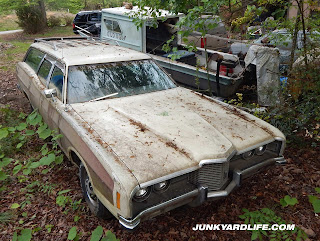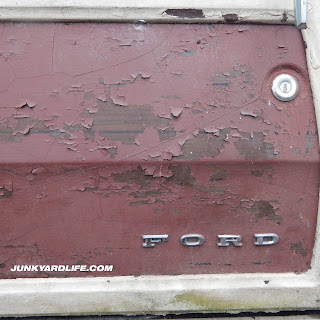
Why the story? Junkyard Life, are the guys who love to bring you the Story Beneath the Rust. Because it is often just as groovy and cool as the car itself. So, I bring you the story beneath this really cool 1971 Ford Country Squire Wagon! Only I failed you. I don’t have the story. Not even a clue. Other than permission to gawk from the property owner, who felt my enthusiasm as a self-proclaimed station wagon geek, I got nothing.
The Mystery Squire Identity Crisis
This wagon contained no paperwork of any kind. No insurance or registration information that I could chase. Due to a long ago repaint, I could not even tell you what dealership sold it. Jody and Keith have pulled my "Junkyard Life Detective License" due to all their questions being answered via my shoulder shrugs and an “I don’t know.” They even put me in that room with a stool and that lightbulb dangling from an unsafe wire. And I still could not tell them anything. I wish I could. I was even wrong about the year. I told the guys it was a 1970 model. It is a 1971. The shame.
But! I do have cool pictures and a ton of research on this wagon, so here we go!
Meanwhile, Back at the Ranch…
My research isn’t even conclusive! Besides being initially mistaken about the year model, I am still in a quandary between what it is and what it says it is. That doesn’t make sense, I know. Hence, the mystery. The codes read, “71H,” indicating that it is a 6-passenger, Custom 500, Ranch Wagon. Clearly, it is a Country Squire 8-passenger with dual-facing rear seats. That should be Code “71E.”
Pretending that we can agree on that, I did learn about the ordering process employed by Ford in that era. How could this wagon be built in both Atlanta, Georgia AND Louisville, Kentucky? Okay, no tug of war in the Southeast in this case. I solved it! The district does not indicate where it was built. That was the district office over the plant where it was built. In this case, like a proper slugger, in Louisville Kentucky. So, it was built in the land of bluegrass, original-recipe chicken, baseball bats, high-dollar horse races and awesome station wagons! When we think of Louisville, Kentucky…we think of Ford Country Squire Wagons. Well, we do now.

Clues!
For fear of redundancy, we really do love the story behind the car. What led it here? Who handed it down and to whom? Why hasn’t this big boat been stripped of useful parts and turned into RC soda cans? Where did it go after it was built in Kentucky? We know it is in Alabama now. It is all of the in-between we want! We wish we knew…there has to be a story here.
HERE ARE THE CLUES:
- Optioned very well with power windows, power door locks, power bench seat, air conditioning and a rocking stereo, for better to hear Glen Campbell and Charlie Pride all while drowning out the sounds of four disgruntled grandsons.
- Actually, cancel out the last part of clue #1 because the interior is in great shape. So much in fact that it showed no signs of seat climbing, scratching and other unspeakable things children do to windows on short trips, much less long ones.
- Under the hood, a new-for-1971 power plant. The Ford 400. More motor than the standard 351-V8, but with a highway friendly 2.75 ratio non-locking rear end. Someone must have had reasons for this, even if it was Ford themselves by some random option combination.
- A full-size wagon would have a C6 transmission as this one does. Did they make a 4-speed Country Squire in 1971? How cool would that have been! Junkyard Life Detectives often end a clue with a question.
- It has a trailer hitch added at some point. But, what did it pull? A boat? A camper? A huge U-Haul? See? Now you are looking at us for answers. We got nothing. Then again, there was an old boat on the property...Now we’re just grasping at straws.
- It does have the optional dual-facing rear seat, and it was set up. Was that for long term storage or was it ready for the kids we think never rode in it? If you had a wagon such as that and did not intend to carry passengers, then we surmise, the back would be used to carry things. In our Oldsmobile Vista Cruiser’s case (Ron’s), we leave all the seats down for utility and parts chasing. Not in this Squire.
- White letter tires that you would associate with mag wheels, but alas…this wagon still rolled (when it rolled) on hub caps. We like that actually, despite it having made no sense at the time.

And They Got Away With it Too, Despite Us Medlin’ Kidds
So, this 1971 well-preserved Country Squire Wagon is still a mystery. I suppose we will just have to celebrate what we do know.
- We know the color. Ford simply called it “Light Gold” when Code 8 was selected to add color to your new wagon.
- Most Country Squires did have the wood grain. Our feature car was repainted at some point and while preserving the exterior metal, it lost something in that translation.
- The rolling stock was Ford’s famous hub cap (I know ours doesn’t match, but the one I feel is original to the car is still there).
- Speaking of what is still there…the grill is in fabulous shape.
- The glass is perfect.
- Under the hood is mostly stock appearing.
- The light green interior, though not for everyone, was a perfect match for us station wagon nerds.
- The year prior to this Mystery Squire (Note to self: Great name for a rock band)* in 1970 was equipped with hide-away headlights. That option made any color look rock and roll.


Nothing but the tail lights
Now we must admit defeat and write a story on a really cool wagon that we know nothing about. No road trip stories. No Yogi the Bear encounters. No baseball mom stories (or hockey mom, if the car was from Canada) Now, we sadly gather our camera, our notebooks and my really cool fedora with a “Press” card in the hat band (Jody loves that hat)** and roll on to find our next car. Maybe even one we can acquire.
Ron Kidd
— Junkyard Life: The Story Beneath the Rust
* Editor’s Note: We apologize for Ron’s lame attempt to name a rock band while doing an article on station wagons.
** Editor’s Note: I do not! I thought I ran over that hat with my truck to get him to stop wearing it a long time ago. Hey, Ron…the 1940’s called. They want their hat back.
















